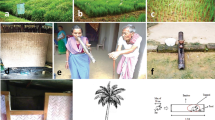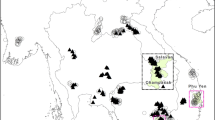Abstract
Indigenous technological knowledge is considered as a traditional knowledge that inherited from their ancestors, unique to a culture, society and environment. In this article we documented uses of such local knowledge used by the local farmers of seven villages form Varanasi, Deoria and Mirzapur districts of eastern Uttar Pradesh, India for their crop protection. Data were collected from 140 respondents (twenty from each village) and 60 respondents who had visited the institute from these three districts during farmers’ fair and farmers’ training and whole making a total of 200 respondents. The farmers in the study developed notable innovations to control major pests of agricultural and horticultural crops such as use of ashes to control vegetable insect pests; use of onion/garlic bulbs, neem leaves, salt crystals, wheat straw, brick kiln powder etc. to prevent store grain pests of cereals; ash and kerosene mixture to repel the sucking pests of rice at milky stage; well-rotted fish scales against Nilgai (Boselaphus tragocamelus); red chilli pods against bruchids in pulses; salt and turmeric powder mixture against ants; use of neem cake to repel termite and other soil insects etc. The local farmers were following these practices because of easy availability, eco-friendly, easy to handle, do not leave any harmful residue, pose any threat to develop resistance and resurgence of secondary pests, easy to apply and compatible with other pest management techniques and socio-cultural situation of the farmers.

Similar content being viewed by others
References
Abbasipour, H., M. Mahmoudvand, F. Rastegar, and M.H. Hosseinpour. 2011. Bioactivities of jimsonweed extract, Datura stramonium L. (Solanaceae), against Tribolium castaneum (Coleoptera: Tenebrionidae). Turkish Journal of Agriculture and Forestry 35: 623–629.
Ali, S., M. Sagheer, M. Hassan, M. Abbas, F. Hafeez, M. Farooq, B. Hussain, M. Saleem, and A. Ghaffar. 2014. Insecticidal activity of turmeric (Curcuma longa) and garlic (Allium sativum) extracts against red flour beetle, Tribolium castaneum: A safe alternative to insecticides in stored commodities. Journal of Entomology and Zoology Studies 2(3): 201–205.
Altieri, M.A. 1993. Ethnoscience and biodiversity: Key elements in the design of sustainable pest management systems for small farmers in developing countries. Agriculture, Ecosystems & Environment 46(1): 257–272.
Atwal, A.S., and G.S. Dhaliwal. 2015. Agricultural pests of South Asia and their management. New Delhi: Kalyani Publishers.
David, B.V. 2001. Elements of economic entomology. Chennai: Popular Book Depot.
Dhaliwal, G.S., R. Arora, and A.K. Dhawan. 2004. Crop losses due to insect pests in Indian Agriculture: An update. Indian Journal of Ecology 31(1): 1–7.
Halder, J., C. Srivastava, and P. Dureja. 2010. Effect of methanolic extracts of Vinca rosea and Callistemon lanceolatus alone and their mixtures against neonate larvae of gram pod borer, Helicoverpa armigera (Hubner). Indian Journal of Agricultural Sciences 80(9): 820–823.
Halder, J., A.B. Rai, and M.H. Kodandaram. 2013. Compatibility of neem oil and different entomopathogens for the management of major vegetable sucking pests. National Academy Science Letters 36(1): 19–25.
Halder, J., A.B. Rai, and M.H. Kodandaram. 2014. Parasitization preference of Diaeretiella rapae (McIntosh) (Hymenoptera: Braconidae) among different aphids in vegetable ecosystem. Indian Journal of Agricultural Sciences 84(11): 1431–1433.
Halder, J., C. Srivastava, P. Dureja, and S. Dhingra. 2012. Effect of essential oils on feeding, survival, growth and development of third instar larvae of Helicoverpa armigera Hubner. National Academy Science Letters 35(4): 271–276.
Meisner, J.M.J., M.S. Tam, and K.R.S. Ascher. 1986. The effect of azadirachtin on the larvae of Europian corn borer. Ostrinia nubilalis. Zeitschrift fur Pflanzenkrankheiten und Pflanzenschutz (Journal of Plant Disease and Protection) 93(6): 585–589.
Morales, H., and I. Perfecto. 2000. Traditional knowledge and pest management in Guatemalan highlands. Agriculture and Human Values 17(1): 49–63.
Navarro, S., B. Timlick, C.J. Demianyk, and N.D.G. White. 2012. Controlled or modified atmospheres. In: Stored product protection, part III—management: Monitoring-based methods, eds. D. W. Hagstrum, T. W. Phillips and G. Cuperus, 1–11. Manhattan, KS: Kansas State University.
Noa, M., and J. Illnait. 1987. Induction of aortic plaques in guinea pigs by exposure to kerosene. Archives of Environmental Health 42: 31–36.
Noa, M., J. Illnait, and R. Gonzalez. 1985. Cytologic and biochemical changes in pulmonary washings of guinea pigs exposed to kerosene. Allergologia et Immunopathologia 13: 193–196.
Noa, N., and J. Sanabria. 1984. Tracheal ultrastructure in kerosene treated guinea pigs. A preliminary report. Allergologia et Immunopathologia 12: 33–36.
Ohkuma, M. 2003. Termite symbiotic systems: Efficient bio-recycling of lignocellulose. Applied Microbiology and Biotechnology 61: 1–9.
Pradhan, S., M.G. Jothwani, and B.K. Rai. 1962. Neem seed deterrent to locust. Indian Farming 12: 7–11.
Rai, A.B., J. Halder, and M.H. Kodandaram. 2014. Emerging insect pest problems in vegetable crops and their management in India: An appraisal. Pest Management in Horticultural Ecosystems 20(2): 113–122.
Rajkumari, R., R.K. Nirmala, P.K. Singh, A.K. Das, B.K. Dutta, and A. Pinokiya. 2014. Ethnoveterinary plants used by the Chiru tribes of Manipur, Northeast India. Indian Journal of Traditional Knowledge 13(2): 368–376.
Saha, D., R. Devi, D. Kashyap, and D.J. Baruah. 2015. Perceived effectiveness of indigenous traditional fishing methods including gears and traps in Nagaon district of Assam. Indian Journal of Traditional Knowledge 1(1): 103–111.
Saxena, R.C. 1998. Botanical pest control. In Critical issues in insect pest management, ed. G.S. Dhaliwal, and E.A. Heinrichs, 155–179. New Delhi: Commonwealth Publishers.
Saxena, R.C. 1982. Note on the use of neem kernel for the protection of dew gram against, Amsacta moorie Butler. Indian Journal of Agricultural Sciences 52: 51–52.
Singh, R.K., B.S. Dwivedi, A. Singh, and S. Tripathy. 2014. Farmers’ knowledge and creativity in eco-friendly pest management: Lessons in sustainable agriculture. Indian Journal of Traditional Knowledge 13(3): 574–581.
Theurkar, S.V. 2014. Investigation of the effects of two different biopesticides on the mortality of Holotrichia serrata F. adults (Coleoptera: Scarabaeidae). International Journal of Pharmaceutical Sciences and Research 5(7): 394–401.
Acknowledgments
Authors are extremely thankful to the Rajendra Singh, Arjun Gupta, Badhu Gupta, Doodh Nath Yadav (village Malhana, District—Deoria), Chandra Dev Yadav, Ram Snehi (village Lachhuman Chak, District—Deoria), Arjun Prasad Dwivedi (village Kodara, District—Deoria); Hiralal Yadav, Lalbahadur Yadav, Rajvali Yadav (village Mahagaon, District—Varanasi); Manu Maurya (village Adalpura, District—Mirzapur) for sharing their valuable traditional knowledge in the field of crop protection. Authors are also wish to thank the Directors, ICAR-IIVR, Varanasi, Uttar Pradesh for providing necessary facilities and help.
Author information
Authors and Affiliations
Corresponding author
Rights and permissions
About this article
Cite this article
Halder, J., Pandey, M.K., Singh, N. et al. Perceived Effectiveness of Indigenous Technological Knowledge (ITK) of Insect and Vertebrate Pests Management in Eastern Uttar Pradesh, India. Proc Zool Soc 71, 9–16 (2018). https://doi.org/10.1007/s12595-016-0179-6
Received:
Revised:
Accepted:
Published:
Issue Date:
DOI: https://doi.org/10.1007/s12595-016-0179-6




